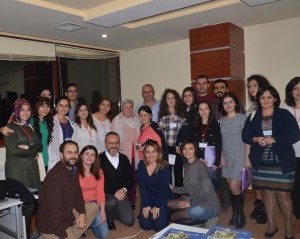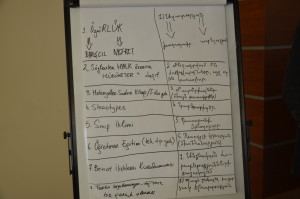Another YavaşGamats School Program Took Place
17:27, December 1, 2015 | News, Own news Another YavaşGamats School took place, this time in autumn, on November 18-22, 2015, in Dilijan town, Armenia. By the time the Armenian participants reached the place where the School was to be held, some of our Turkish colleagues and participants had already managed to see the town, visited Haghartsin monastery and enjoyed having a rest in the open air there.
Another YavaşGamats School took place, this time in autumn, on November 18-22, 2015, in Dilijan town, Armenia. By the time the Armenian participants reached the place where the School was to be held, some of our Turkish colleagues and participants had already managed to see the town, visited Haghartsin monastery and enjoyed having a rest in the open air there.
This has already been the fourth School. The first one took place in 2005. Then there was a lengthy break in Armenian-Turkish relations on this level as well, which were supported by HCA Vanadzor and HCA Turkey /Istanbul/. The other two School Programs took place in 2014 and 2015, in Turkey and Armenia, respectively. This time, the Program was held in Armenia again and was attended by 20 teachers and students of educational institutions from various regions of Turkey and Armenia. This School Program mostly targeted teaching of history and historiography.
The 5-day Program covered lectures by Armenian and Turkish historians, history and literature teachers and instructors on the significant role of teachers in teaching history and literature, as well as of educational systems of both countries, and details on depicting Turks and Armenians in Armenian and Turkish history textbooks. The lectures were accompanied by discussions.
 On the 1st day, the Program participants got familiar with the aims and objectives of the Program. Esra Güçlüer, representative of HCA Turkey, talked about the history of long cooperation between HCA Turkey and HCA Vanadzor. Olya Azatyan, representing the British Embassy in Yerevan, and Aline Ozinian, regional analyst, Armenian Assembly of America, shared their personal experiences and stories in the context of the Armenian-Turkish relations. The latter introduced the topic “How does it feel being an Armenian in Turkey? Childhood while Armenians were Enemies in History Textbooks.” Then the participants got acquainted with each other and shared their expectations.
On the 1st day, the Program participants got familiar with the aims and objectives of the Program. Esra Güçlüer, representative of HCA Turkey, talked about the history of long cooperation between HCA Turkey and HCA Vanadzor. Olya Azatyan, representing the British Embassy in Yerevan, and Aline Ozinian, regional analyst, Armenian Assembly of America, shared their personal experiences and stories in the context of the Armenian-Turkish relations. The latter introduced the topic “How does it feel being an Armenian in Turkey? Childhood while Armenians were Enemies in History Textbooks.” Then the participants got acquainted with each other and shared their expectations.
On the following days, the Program participants discussed the current problems in the Armenian and Turkish educational systems that hinder the efforts towards eliminating the hostile attitudes toward each other and breaking the stereotypes, as well as the dependence, freedom or suppression of the teachers in shaping both positive and negative attitudes towards Armenians or Turks.
The discussions and presentations within the School Program activities mostly concerned the issues on how Armenians/Turks are referred to in Turkish/Armenian History textbooks /courses/; when and how Armenians/Turks were first mentioned in the history books of each of the countries; what the official position on the Armenian Genocide in Turkish curriculum was and how the issues of Turkey and the Ottoman Empire were described. The Program participants also touched upon the possibility of alternatives of teaching history and what is lacking in the school and academic history textbooks in Armenia and Turkey, including the formation of public knowledge about Armenia and Armenians in the Republican Turkey and formation of public knowledge about Turks and Turkey in the in Soviet Armenia.
The participants attached importance to the approaches of teaching history, which is necessary for peacebuilding and trust, and for understanding recent history through literature as a guide. All these topics were introduced by Armenian and Turkish historians, historiography experts and ethnographers.
Along with the lectures and discussions, the School participants were divided into 2 large groups, so that within the following 2 days they started to think about the barriers/restrictions in their educational systems on the way to peace-building or about the obstacles they faced in building peace as teachers, bringing the example of having stereotypes about each other.
First, the participants worked in groups to reveal such obstacles/restrictions and as a result, presented the problems and restrictions below:
- – failure to provide non-official historiography in the educational system;
- – teachers’ fear not to oppose their government’s official position, which is most pronounced and restricted in Turkey;
- – limitation of identities by “one nation, one state, one language” concept;
- – negative position starting from the family;
- – failure to present Armenian songs or music at music lessons or one-sided presentation of literature lessons in Turkey;
- – no optional language classes;
- – showing negative images when presenting some materials through images, etc.
After presentations of the problems and restrictions above, the Program participants worked out the methods and strategies that could be used to resolve the problems or break the stereotypes.
During the presentations the participants underlined that teachers should tell and show children that whatever is related to peace is positive and whatever is related to war is negative. They tried to show through a model lesson the difference between war and peace by pointing to the negative aspects of the war, so that children come closer to peace through disliking war. The participants also emphasized that states and the public should reject the war and say a more explicit and emphatic “no” to it. They believed that the education aimed at peace-building should start from pre-school and continue through the middle and high school. Also, the participants made a number of suggestions to improve the Armenian-Turkish relations, including mutual steps to present to each other the holidays of the other, celebrate such holidays and disseminate among the 2 nations their ideas through the NGOs.
As one of the participants said, “No matter how bad the textbooks or teaching resources might be, teachers with critical thinking can use such resources in the way they wish and skip some unwanted ones, if necessary. Today, we learn and teach history through war. While there are more years of peace between the nations, we present only the war of several years as if we teach military history rather than human one. And once teachers can present everything in the way described above, they’ll do a great job.” 
The participants also highlighted the role of media in promoting peace, which might have a major impact on forming public opinion, and teachers’ role in teaching children to use the media, since the information or broadcasts they heard or watched might be dangerous for them in terms of forming their own opinions. They also considered it necessary to point out examples of discrimination in the mass media and show the coverage of Armenia and Turkey in the mass media of the both countries. The participants discussed the possibility of translating and teaching fairy tales by Armenian writers as an option on the way to peace-building. Another suggestion was that each of the participants told their students or people around them about the School and that the school students of both countries conveyed messages to each other from their classrooms.
To sum up, Artur Sakunts, the chairman of HCA Vanadzor considered and assessed the closed Armenian-Turkish border as an absurdity and something anti-civilization in the 21st century. He also highlighted the necessity of overcoming the obstacle of closed borders through educational system. “One of the main goals, if not the primary goal of YavaşGamats is to open the Armenian-Turkish border, and not only about the physical border, but also the between minds, relationships and self-expression to achieve full human cooperation.”
The School Program was held within the framework of the project Armenian-Turkish Dialogue Support: Ongoing YavasGamats process funded by UK Conflict, Stability and Security Fund via British Embassy Yerevan
